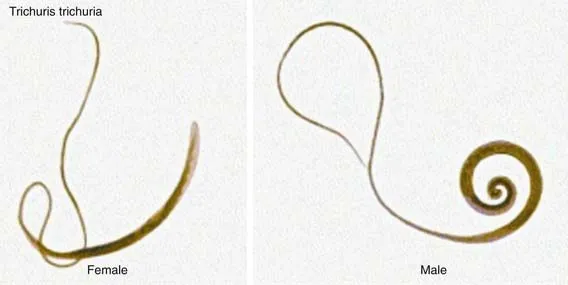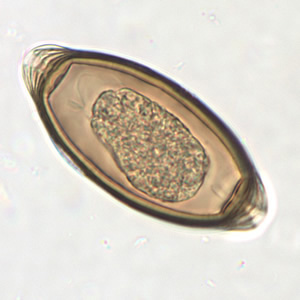Trichuris trichiura - Pathogenicity, Pathology, Lab diagnosis, Clinical Manifestation, Epidemiology
Pathogenicity, Pathology of Trichuris trichiura
The adult Trichuris trichiura worm invades the intestinal mucosa (mostly in the caecum, colon, and sometimes rectum). With the help of a thin, thread-like anterior end, it feeds on tissue secretions but not on blood.
Pathogenicity of adult Trichuris trichiura includes occasional eosinophilia resulting due to bleeding in the intestinal mucosa at their site of attachment. Pathological changes include petechial hemorrhage, inflammation, mucosal bleeding, and edema.
In an infected human, approximately, 0.005 ml of blood per worm is lost.
Due to the metabolic products released by the worm, allergic reactions/manifestations can appear in the host including urticaria, and respiratory disorders.
Host Immunity of Trichuris trichiura
Although the information on the host immunity against Trichuris trichiura is limited, it is known that defense against reinfection is absent as infection is frequently seen in older people.
Clinical Manifestations of Trichuris trichiura
The clinical manifestations of Trichuris trichiura depend on the load of the parasite in the intestine.
Light Trichuris trichiura infection
light Trichuris trichiura infection is the worm load of 100 worms to 200 worms
most of such infections are asymptomatic
Heavy Trichuris trichiura infection
if more than 200 parasites are infecting a person at the time, it is referred to as a heavy Trichuris trichiura infection
often seen in children, especially in small children who eat a lot of dirt
clinical manifestation of heavy Trichuris trichiura infection includes vague abdominal discomfort, growth retardation, and diarrhea with occasional blood and mucus production
if the whipworm load is more than 800, serious manifestations may arise such as anemia, abdominal pain, nausea, vomiting, weight, loss, dysentery
heavy Trichuris trichiura infection in the colon and rectum may also result in the rectum
in cases the parasites migrate into the appendix, appendicitis may occur
Complications of Trichuris trichiura
Complications of Trichuris trichiura include rectal prolapse or anemia.
Prognosis of Trichuris trichiura
The prognosis of Trichuris trichiura is excellent and is rarely fatal. In most cases, the infection is self-limiting. Recovery takes place 5-6 weeks after infection.

Image: adult Trichuris trichiura (Source: Clinical Gate)
Epidemiology of Trichuris trichiura
Epidemiologically, Trichuris trichiura is most prevalent in tropical and sub-tropical countries with the warmest soil. Cases have been reported in Africa, South America, and South-East Asia.
Reservoir, Source of Trichuris trichiura
The main source of Trichuris trichiura infection is soil and food contaminated with embryonated eggs while an infected man is a reservoir for the whipworm parasite.
Transmission of Trichuris trichiura
The transmission of Trichuris trichiura occurs by the following methods:
improper hygiene – contaminated fingers
ingestion of embryonated eggs present in food and water
Laboratory diagnosis of Trichuris trichiura
The laboratory diagnosis of Trichuris trichiura is done by demonstration of barrel-shaped eggs in the fecal sample.
Sample
stool/feces
rectal mucosa
Microscopy
Microscopy for the laboratory diagnosis of Trichuris trichiura involves the use of light microscopy. The presence of the characteristic barrel-shaped eggs in the fecal sample confirms the infection.
Moreover, the concentration of samples can be done by the formalin-ether sedimentation method. In cases of heavy infections, adult worms can also be seen in rectal mucosa samples

Image: Trichuris trichiura egg (Source: CDC)
Treatment of Trichuris trichiura
The drug of choice used for the treatment of Trichuris trichiura infection is mebendazole.
Prevention, Control of Trichuris trichiura
The prevention and control of Trichuris trichiura can be obtained by following steps:
immediate treatment of infected people to contain the reservoirs
reduce contamination of water sources by human feces i.e. proper sewage disposal
proper washing of food that is consumed raw such as salads
boiling and/or filtration of drinking water
not using human feces as source of fertilizer